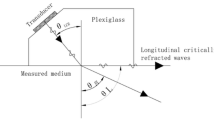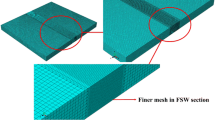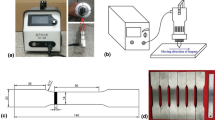Abstract
Correction method for microstructure effect on residual stress of self-reacting friction stir weld joint measured with longitudinal critically refracted wave was discussed in this study. Two longitudinal critically refracted wave transducers, the spacing between which was fixed, were used, then the acoustoelastic formula was optimized, and difference in time of flight between longitudinal critically refracted wave, which replaced propagation velocity as characteristic parameter for residual stress measurement, was determined by the cross correlation theory, at last the influence of microstructure on residual stress of self-reacting friction stir weld joint was solved. Results show that as stress increases, the deviation in difference in time of flight becomes obvious, and when stress reaches stress turning point, experimental result is not agreed with the acoustoelastic theory as stress increases further. Step length is an important factor for difference in time of flight, and one cycle is seen as optimal step length. For acoustoelastic coefficient, the value of nugget zone is biggest, and the value of (heat affected zone + thermal mechanical affected zone) is smallest, in addition, the value of advancing side is slightly bigger than that of retreating side. Finally, residual stress of self-reacting friction stir weld joint was corrected with longitudinal critically refracted wave, and the result is verified by hole-drilling.










Similar content being viewed by others
REFERENCES
Chen, S.J., Li, H., Lu, S., et al., Temperature measurement and control of bobbin tool friction stir welding, Int. J. Adv. Manuf. Technol., 2016, vol. 9, pp. 1–10.
Chen, S.J., Zhou, Y., Xue, J.R., et al., High rotation speed friction stir welding for 2014 aluminum alloy thin sheets, J. Mater. Eng. Perform., 2017, vol. 26, no. 3, pp. 1337–1345.
Chen, S.J., Li, H., Wu, M.F., et al., Torque oscillation characteristics in the process of bobbin tool friction stir welding, J. Vib. Eng., 2016, vol. 18, no. 1, pp. 70–80.
Liu, C. and Yi, X., Residual stress measurement on AA6061-T6 aluminum alloy friction stir butt welds using contour method, Mater. Des., 2013, vol. 46, pp. 366–371.
Husson, D., A perturbation theory for the acoustoelastic effect of surface waves, Am.Inst. Phys., 1985, vol. 57, pp. 1562–1568.
Ditri, J., Determination of non-uniform stresses in an isotropic elastic half space from measurements of the dispersion of surface waves, J. Mech. Phys. Sol., 1997, vol. 45, pp. 51–56.
Javadi, Y., Pirzaman, H.S., Raeisi, M.H., et al., Ultrasonic stress evaluation through thickness of a stainless steel pressure vessel, Int. J. Pressure Vessels Piping, 2014, vols. 123–124, pp. 111–120.
Javadi, Y., Akhlaghi, M., and Najafabadi, M.A., Using finite element and ultrasonic method to evaluate welding longitudinal residual stress through the thickness in austenitic stainless steel plates, Mater. Des., 2013, vol. 45, pp. 628–642.
Sadeghi, S., Najafabadi, M.A., Javadi, Y., et al., Using ultrasonic waves and finite element method to evaluate through-thickness residual stresses distribution in the friction stir welding of aluminum plates, Mater. Des., 2013, vol. 52, pp. 870–880.
Belahcene, F. and Lu, J., Determination of residual stress using critically refracted longitudinal waves and immersion mode, J. Strain Anal. Eng., 2002, vol. 37, pp. 13–20.
Zhan, Y., Liu, C.S., Kong, X.W., et al., Experiment and numerical simulation for laser ultrasonic measurement of residual stress, Ultrasonics, 2017, vol. 73, pp. 271–276.
Xu, C.G., Song, W.T., Pan, Q.X., et al., Nondestructive testing residual stress using ultrasonic critical refracted longitudinal wave, Phys. Process., 2015, vol. 70, pp. 594–598.
Yashar, J., Seyedali, S., and Mehdi, A.N., Taguchi optimization and ultrasonic measurement of residual stresses in the friction stir welding, Mater. Des., 2014, vol. 55, pp. 27–34.
Yashar, J. and Mehdi, A.N., Comparison between contact and immersion ultrasonic method to evaluate welding residual stresses of dissimilar joints, Mater. Des., 2014, 47: 473–482.
Hakan, G.C. and Orkun, T.B., Nondestructive investigation of the effect of quenching and tempering on medium-carbon low alloy steels, Int. J. Microst. Mater. Prop., 2005, vol. 1, pp. 51–60.
Siamak, A. and Rasool, M., Improvement in accuracy of the measurements of residual stresses due to circumferential welds in thin-walled pipe using Rayleigh wave method, Nucl. Eng. Des., 2009, vol. 239, pp. 2201–2208.
Liu, B. and Dong, S.Y., Anisotropic structure affects thickness measurement of laser cladding coating with surface ultrasonic wave based on cross-correlation function, Mater. Res. Innovations, 2015, vol. 19, no. 5, pp. 194–198.
Palanichamy, P., Joseph, A., and Jayakumar, T., Ultrasonic velocity measurements for estimation of grain size in austenitic stainless steel, NDT&E Int., 1995, vol. 28, pp. 179–185.
Liu, B., Miao, W.B., Dong, S.Y., et al., Grain size effect on Lcr elastic wave for surface stress measurement of carbon steel, Nondestr. Test. Eval., 2018, vol. 33, no. 2, pp. 139–153.
Leon-Salamanca, T. and Bray, D.F., Residual stress measurement in steel plates and welds using critically refracted longitudinal (LCR) waves, J. Res. Nondestr. Eval., 1996, vol. 7, no. 4, pp. 169–184.
Hugues, D.S. and Kelly, J.L., Second-order elastic deformation of solid, Phys. Rev., 1951, vol. 92, pp. 1145–1149.
Zhang, L. and Wu, X.L., On the application of cross correlation function to subsample discrete time delay estimation, Digital Signal Process., 2006, vol. 16, pp. 682–694.
Ouyang, X.X., Luo, L.Y., and Xiong, J.Y., Time delay estimation using windowed differential magnitude of cross correlation and its Hilbert transform, Process. Eng., 2012, vol. 29, pp. 2033–2038.
Liu, B. and Dong, S.Y., Stress evaluation of laser cladding coating with critically refracted longitudinal wave based on cross correlation function, Appl. Acoust., 2016, vol. 101, pp. 98–103.
Funding
This work was supported by the National Natural Science Foundation of China (Grant no. 51775254) and China Postdoctoral Science Foundation (grant no. 2016M591795).
Author information
Authors and Affiliations
Corresponding author
Rights and permissions
About this article
Cite this article
Liu, B., Li, J., Dong, S. et al. Correction for Microstructure Effect on Residual Stress Measurement of SR-FSW Joint with Lcr Wave. Russ J Nondestruct Test 56, 131–140 (2020). https://doi.org/10.1134/S1061830920020023
Received:
Revised:
Accepted:
Published:
Issue Date:
DOI: https://doi.org/10.1134/S1061830920020023




